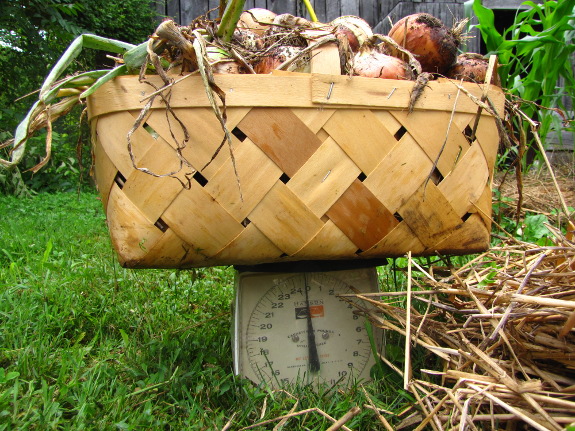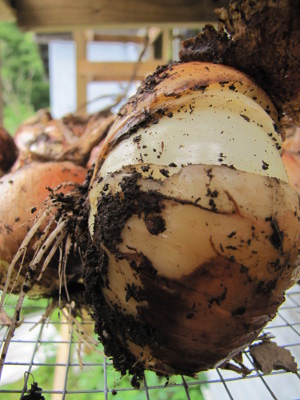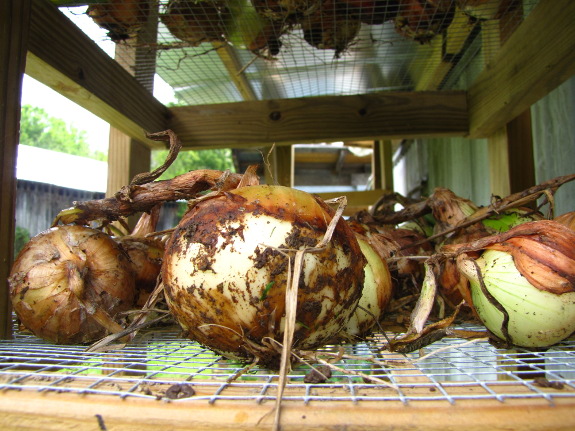
Partial onion harvest

 I
usually wait to harvest my storage onions until the tops have died back
on all of the bulbs, but this year it seemed more prudent to take in
half early, then plan on a second harvest to round up the stragglers
who are still green.
I
usually wait to harvest my storage onions until the tops have died back
on all of the bulbs, but this year it seemed more prudent to take in
half early, then plan on a second harvest to round up the stragglers
who are still green.
Wet weather just before
harvest is bad for root crops, and the forecast says we're in for
another week of rain. Already, a few of the onions had started to
rot and several others had split their outer layers, which means they
won't keep quite as long.
I can't complain,
though, since we've now got 46 pounds of onions on our curing
racks, with at least
that many yet to come out of the ground.

My extended onion
harvest means the racks will be full for the rest of
July and probably part of August, then I'll press them into service
again in late September for sweet potatoes, followed closely by winter
squash. After the porch and straw door, I think our vegetable
curing tower may be the infrastructure improvement that has seen the
most use this year.
Want more in-depth information? Browse through our books.
Or explore more posts by date or by subject.
About us: Anna Hess and Mark Hamilton spent over a decade living self-sufficiently in the mountains of Virginia before moving north to start over from scratch in the foothills of Ohio. They've experimented with permaculture, no-till gardening, trailersteading, home-based microbusinesses and much more, writing about their adventures in both blogs and books.
Want to be notified when new comments are posted on this page? Click on the RSS button after you add a comment to subscribe to the comment feed, or simply check the box beside "email replies to me" while writing your comment.

I've gone back through the posts to see if you posted a total square footage, but don't see a mention (I might have missed it.) With the 6 racks, how many square feet of drying space do you have? How many pounds of garlic were you able to fit on them and did all 46 pounds of onions fit?
I'm thinking of investing in starter garlic this year. I will definitely try to buy 'local' stock for adaptation and replant the largest cloves from the largest heads in subsequent years. There are so many varieties out there and it is so hard to choose up front (but would like to make a 'one time' investment, if possible.) I'm wondering how many varieties I should start with. I'm new to garlic production so realize I will learn along the way. I was thinking of 2 lbs of starter stock with 1/4 each of 8 varieties (mixed hardneck and softneck.) There are options that would also include artichoke and elephant varieties. Would love to hear from you on starting with so many varieties and other commenters who have favorites or experiences related to flavor, storage, or productivity (would be produced in the Pacific Northwest Coastal zone.)
Finally, do you weight before and after curing? Do you have a sense of how much weight loss you have during curing?
How do your multiplier onions look this year? I'm looking forward to hearing your thoughts on the newer variety from Southern Exposure Seed Exchange.
Charity --- We have six racks, each of which is a little less than 4 square feet in area, so we have 24 square feet of rack total. We only used half that area for the 46 pounds of onions because I knew I'd have a similar amount coming in. That was a bit tight, but should work fine.
We had 30 pounds of garlic (once dried) this year. I could have used more space, but all six racks got the garlic good and dry.
I'll let others chime in about your local garlic selection. We tried several varieties at first, and none were duds. On the other hand, some did produce better than others. How many varieties you want to try should be influenced by how well you keep track of complicated arrangements, otherwise they'll all run together either in storage or in the garden.
We usually only weigh after curing, but I weighed the onions before this time. The reason I did is because I'm trying out two different varieties and wanted to make sure I got at least some data on how each did before they potentially got mixed together. (I'll post about the varieties later once the data's all in.)
You must have missed our followup potato onion post.